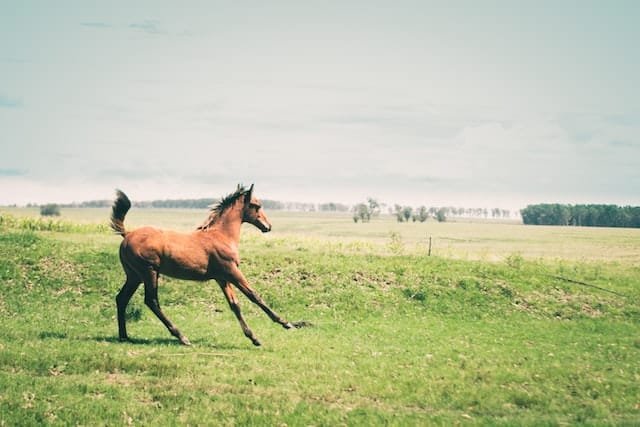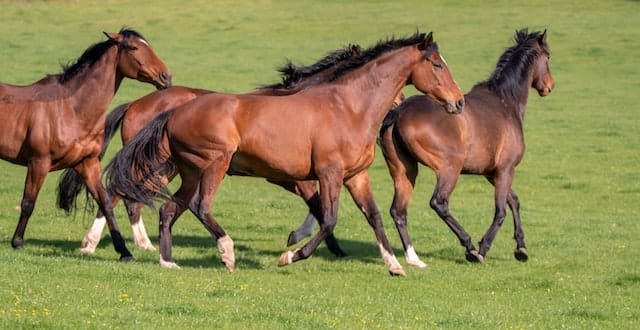What do horses do? Well, a lot! Horses are versatile animals and there is a lot that they can do. There are things that horses do by themselves. And there are things that we humans make them do.
In this article, I’m going to try and list everything that a horse can potentially do regardless of whether it is instinctive or trained, voluntary or forced.
So if you’re looking for a long list of what horses can do, then buckle up. This article’s for you!
What Do Horses Do?
The long list of what horses can do can be split into different categories. There are things that horses do simply to survive – eat, drink, run from predators.
Then there are things that they do because we humans have trained them to do so – letting us ride them, run in races, etc. And finally, there are things that horses are unfortunately forced to so – eg. participate in rodeos or circuses.

So, what do horses do? Here’s the long list:
- Horses eat, drink and poop
- Horses run (for fun and from danger)
- Horses get scared (of many things)
- Horses kick and bite
- Horses mate and give birth
- Horses groom themselves and each other
- Horses play with each other
- Horses work on farms
- Horses carry or pull loads
- Horses provide companionship
- Horses let us ride them
- Horses run in races
- Horses eat grass (and may need nothing else)
- Horses digest cellulose
- Horses extract protein from grass (Yes, really!)
- Horses protect their young and old
- Horses give joy and are used in equine therapy
So with that let’s take a brief look at each of these things that horses do.
#1. Horses eat, drink and poop
Like all animals, horses need to eat and drink to survive. They also need to poop. Horses are made to eat grass. Over millions of years of evolution, their anatomies have adapted to eating just grass and extracting maximum nutrients from it.
During summer many horses will eat grass by grazing in pastures and meadows. In the winter, in the absence of fresh grass, horses can eat hay and get the same nutritional value out of it.
As for drinking, just plain water is all they need. It just has to be clean. Horse poop can be an excellent fertilizer and is often used on farms to supplement commercial fertilizer.
#2. Horses run (for fun and from danger)
Horses are born runners. Once again, evolution has given them what they need to run. Their legs are strong and flexible, and their bodies are built for speed.
Their ability to run developed in response to escaping predators and finding food. Horses are fight-or-flight animals but given the choice, they will choose flight over fight. This is why horses can very quickly break into a sprint and why they can run very fast.
A horse’s anatomy and physiology are also built for running. For instance, their legs are long in proportion to their bodies. This allows them to long strides and cover more distance for the same energy exerted. This is one of the reasons why horses can run for long.
Horses also enjoy running for fun. In the wild, horses will often engage in what is known as “frolicking” or playing. They will run around and gallop together, seemingly having fun. You can see this behavior in many domesticated horses as well.
#3. Horses get scared (of many things)
Horses, as I’m sure you know, are extremely skittish. They seem to be scared of everything from noises and sudden movements to strange objects. For example, a horse may startle at the sound of a car backfiring or when a plastic bag suddenly blows across their field.
But what horses are really afraid of are their natural predators. These include mountain lions, coyotes, bears and wolves. Their fear of predators is what causes them to flee at the slightest hint of danger, even when there’s no actual danger present.
Having said that horses are usually not afraid of animals that are not their natural predators like snakes, pigs, deer or spiders. However, when these animals make surprise moves or sudden noises, horses may still get scared.
#4. Horses kick and bite
Horses kick and bite for a variety of reasons. They may kick if they feel threatened, or if someone is trying to do something with them against their will. They bite out of fear or anger.
Horses may also kick and bite each other if they do not get along. This is a sign of dominance and a way for the horses to “talk” to each other.
Finally, horses may kick or bite out of what is known as “play aggression.” This is when a horse gets so excited that they may lash out in what appears to be an aggressive manner.
For these reasons, it is important to never approach or attempt to handle a horse without knowing what you are doing.
#5. Horses mate and give birth
Needless to say, horses mate and give birth. This is a natural occurrence in the wild, while with domesticated horses this is usually managed by their owners.
Female horses are called mares and males are called stallions. Mares come into heat in the spring and summer, during what is known as the “breeding season.” Mares cycle through a period of heat, during which they are receptive to the advances of a male horse.
Stallions are usually the ones that initiate mating. A stallion will approach a mare in heat and court her by circling around her and licking or nuzzling her. If the mare is receptive, mating will occur.
After mating, the mare will carry the foal for 11 months before giving birth. Once the foal is born, it will stay with its mother for at least a year. During this time, the mare will teach her foal how to behave and what dangers to look out for.
#6. Horses groom themselves and each other
Grooming is an important part of horse care. Horses naturally groom themselves, taking great care to keep their coats clean and free of parasites.
Horses also groom each other. This is an important part of their social behavior, as it helps build relationships between them and creates a sense of trust. For instance, when a horse is grooming another, the receiving horse will typically stand still and relax.
In addition to cleaning their coats, horses will also groom each other’s manes and tails. This helps keep the hair healthy and tangle-free.
Overall, horses are highly social animals and grooming is an important part of their relationships.
#7. Horses play with each other
Part of being social means that horses also like to play with each other. This behavior usually takes place in the form of what is known as “horseplay.”
Horseplay usually involves running, kicking and chasing. Horses may also engage in what is known as “shadow boxing” which is when they stand in one spot and kick at what appears to be an imaginary opponent.
Sometimes, horses may even playfully nip each other. This is usually harmless and is part of how they interact with each other.
Ultimately, horseplay helps keep horses mentally and physically healthy. It helps them form relationships and build trust with each other, as well as helps them to release excess energy in a healthy way.
#8. Horses work on farms
A century ago, horses were widely used as working animals on farms. In those days, horses pulled plows, wagons and carts across the fields. But after World War I, tractors began to take over and the role of horses on a farm began to diminish.
However, in many farms, horses are seeing a resurgence as farmers begin to see the benefits of using horses on farms instead of mechanized vehicles.
Horses can help herd cattle, carry or pull heavy loads, provide natural fertilizer and assist in tilling and plowing. They can be especially useful in areas that are inaccessible to tractors or other heavy machinery.
In addition, some farms offer what is known as “horse-drawn touring” where visitors can take a ride in a horse-drawn wagon or carriage.
Overall, horses provide many benefits on farms and are becoming more popular as farmers look for ways to increase efficiency and reduce their environmental footprint.
#9. Horses carry or pull loads
As we saw above, horses have historically been used to pull carts and carriages. But the use of horses for transport has not disappeared with the advent of motorized vehicles.
In some parts of the world, horses are still used to pull carts filled with goods. This is especially true in rural areas where motorized vehicles are not common.
Horses also pull sleds in some areas, especially in the winter. These are similar to carts, but they have runners on the bottom so that they can be pulled over snow and ice.
In addition, horses can be used to carry passengers. This is especially popular in mountainous areas, where horses are able to traverse steep and rocky terrain that cars and trucks cannot.
Overall, horses offer a reliable and strong form of transport in areas where motorized transportation is not always available.
#10. Horses provide companionship
One of the most wonderful things horses can do is provide companionship. Horses are intelligent and sensitive animals, so they can form strong bonds with humans.
Because horses are social animals, they enjoy interacting with other animals – including humans. Spending time with a horse can be incredibly rewarding and relaxing, as you get to know the individual personality of each horse.
In some cases, horses may even be used as therapy animals. They can help people with a range of issues from anxiety and depression to physical disabilities. We’ll cover this point later in the article.
#11. Horses let us ride them
One of the amazing things that horses do is to let us ride them. Think about it. We can sit on their backs and they will carry us wherever we want to go. How many animals let us do that?
Riding a horse is an enjoyable experience that has been around for centuries. It can be a thrilling way to explore the countryside or just a relaxing way to get some fresh air and exercise. Riding also helps to build a strong bond between horse and rider, as the horse learns to trust its human companion.
Riding can also be competitive, with riders taking part in horse shows, dressage competitions and cross-country events. There are even some long-distance endurance riding races where riders have to cover hundreds of miles. A well-known endurance race is The Western States Trail Ride also known as the Tevis Cup.
#12. Horses run in races
A part of horse riding includes participating in racing events. Horse races have been around for centuries, and today they are still incredibly popular, with millions of people watching them on television or attending in person.
Popular horse races include the Kentucky Derby in the US and the Grand National in the UK, and they attract huge crowds of spectators every year.
Horse racing is not just about entertainment; it’s also a major source of employment and revenue for many countries and communities.
#13. Horses eat grass (and may need nothing else)
As we saw earlier in this article horses eat grass. Almost everyone knows that. But what is remarkable about horses is that they seem to have no need for anything else. Amazingly, they are able to extract almost all the nutrients they need from grass (or hay).
A horse’s nutritional needs are not that different than ours. They too need a balanced diet that includes protein, carbs, fat, minerals and water. And yes, they can get most, if not all, of this from grass.
#14. Horses digest cellulose
One of the reasons horses can eat grass and nothing else is their ability to digest cellulose. Cellulose is a complex carbohydrate that is one of the main components of the cell walls of plants. And, as such, it’s cellulose that gives a plants its form and structure.
Cellulose is insoluble and indigestible in most mammals including humans. Cellulose is the “fiber” we refer to when we eat vegetables. It is the roughage that gives bulk to our stools and makes us regular. In that sense, cellulose is very important to us humans.
But the enzymes in our stomach that break down food are not able to break down cellulose and it passes through our digestive tracks virtually unaltered. On the other hand, horses can digest cellulose through a process called hindgut fermentation. Bacteria in the horse’s gut (colon and cecum) break down the cellulose allowing the horse to extract additional nutrients from the grass.
#15. Horses extract protein from grass (Yes, really!)
Have you ever wondered how horses can be herbivores and still be so muscular and strong? Where do they their protein from? Sure, some horse owners may give their horses protein supplements but what about horses in the wild? They are just as muscular.
The answer lies once again in this magical digestion process called hindgut fermentation. It is the breaking down of cellulose by the bacteria in the horse’s gut that allows the horse to extract the protein from the grass and meet its protein needs.
This is why horses can get protein from grass while we humans cannot. This is one of nature’s amazing adaptations to allow the horse to live off of its natural food – grass – and thrive.
#16. Horses protect their young and old
Horses are herd animals and they have very strong social bonds. This means that they look out for each other, particularly the young and the old.
Young foals are kept close to their mothers, with the mother and other mares in the herd taking turns looking after them. Older horses are also given special care from the other horses in the herd.
This herd behavior is seen often in wild horses. When a herd of horses travels, the foals and old horses are usually kept in the middle of the herd, surrounded by adult and stronger horses. This way, they can be easily protected from predators and other dangers.
#17. Horses give joy and are used in equine therapy
Equine therapy is a type of therapy that uses horses as part of the treatment process. It is used to help people with mental and physical disabilities, post-traumatic stress disorder, traumatic brain injuries, substance abuse, depression and more.
There are several different types of equine therapy, but the common goal is to help people create a bond with horses and use that bond to help them heal and grow.
The therapy can take many forms, from simply being around horses to engaging in activities like horseback riding, grooming, feeding and caring for horses. The idea is to use the unique relationship between a person and a horse as an avenue for teaching, healing and growth.
Equine therapy can also be used as part of physical rehabilitation for people recovering from injuries or surgery. The motion of the horse helps to increase circulation, joint movement, and strength. It can also help with balance and coordination.
Wrapping Up
So there you have it. In case you’re wondering – what do horses do – here’s a long list of things they do. I’m sure that there are more things and I have missed some. I’ll keep updating this post as I come across more things these animals can do.
Horses are truly amazing animals, with an incredible ability to adapt and survive in nature. Their resilience, strength and social bonds are what make them so special and why people love them.
Whether you own horses or just admire them, they can teach us all a lot about what it means to be resilient, strong and connected.
So next time you come across a horse, take some time to appreciate all that they can do!



